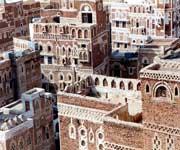The old city of Sana'a is an outstanding example of a homogeneous architectural ensemble whose design and detail illustrate an organization of space characteristic of the early centuries of Islam which has been respected over time. The houses of Sana'a, which have become vulnerable as a result of contemporary social changes, are an outstanding example of a unique, traditional human settlement. Countless partial studies have been made of the houses of Sana'a, with the objective of eventual demolition. The beauty of the urban landscape of Sana'a, whose overall appearance should remain intact, attests that they should be preserved integrally.
Continent: Asia
Country: Yemen
Category: Cultural
Criterion: (IV)(V) (VI)
Date of Inscription: 1986
Sana'a, the Capital of Yemen
The City of Sana'a, capital of Yemen since 1962, is a fine example of artistic and pictorial quality, now considered to be a homogenous ensemble made up of tower-houses built from rammed earth. Its history covers a period of over 2,000 years. Given official status in the 2nd century BC when it was an outpost of the Yemenite kingdoms, Sana'a (Arabic for 'fortified place') was associated with all the major historical events that took place in Arabia Felix. The site of the cathedral and the martyrium constructed during the period of Abyssinian domination (525-75) bear witness to Christian influence whose apogee coincided with the reign of Justinian.
 |
| The Old City of Sana'a Yemen |
Browse Gallery Plus UNESCO Storyline
Sana'a during pre-Islamic period
The remains of the pre-Islamic period were largely destroyed as a result of profound changes in the city from 628. Beginning with the early years of the Hegira, Sana'a became a major centre for the spread of the Islamic faith. The Great Mosque is said to have been constructed while the Prophet was still living, with materials recovered from the Ghumdan Palace and the cathedral.
The successive reconstructions of Sana'a under Ottoman domination, beginning in the 16th century, respected the proportions and balance of the medieval city while changing its appearance. At the same time, a new city grew up to the west of the first settlement and is contiguous with it. The new city covers a similar surface area.
The houses in the old city are of relatively recent construction and have a traditional structure. The stone-built ground floor houses provisions and livestock. A staircase leads to the upper floors which normally comprise, successively, a large common room, which served as a meeting room for business affairs; the divan, used exclusively for festivities and family gatherings; smaller, private living quarters; and, last, on the top floor, the mafraj, a room where men meet in the afternoon.
Large windows line three walls of the room forming a kind of loggia. The only differentiating feature of these tower-like houses is the size and number of floors (there may be as many as nine), and the quality of the ornamental and painted decoration of the windows, friezes and coping.
Browse All UNESCO World Heritage Sites in
Yemen. The original UNESCO inscription
Here!!!











No comments:
Post a Comment